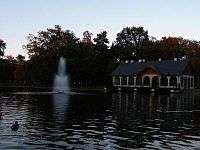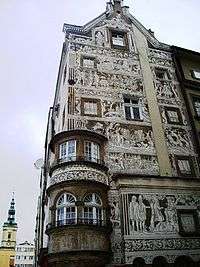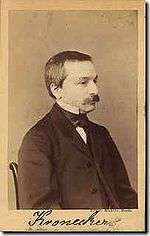Legnica
| Legnica | |||
|---|---|---|---|
|
Legnica | |||
| |||
 Legnica | |||
| Coordinates: 51°12′30″N 16°9′37″E / 51.20833°N 16.16028°E | |||
| Country | Poland | ||
| Voivodeship | Lower Silesian | ||
| County | city county | ||
| Established | 1149 | ||
| Town rights | 1264 | ||
| Government | |||
| • Mayor | Tadeusz Krzakowski | ||
| Area | |||
| • Total | 56.29 km2 (21.73 sq mi) | ||
| Elevation | 113 m (371 ft) | ||
| Population (31.12.2012) | |||
| • Total | 102,708 | ||
| • Density | 1,800/km2 (4,700/sq mi) | ||
| Time zone | CET (UTC+1) | ||
| • Summer (DST) | CEST (UTC+2) | ||
| Postal code | 59-200 to 59-220 | ||
| Area code | +48 76 | ||
| Car plates | DL | ||
| Website | http://www.legnica.um.gov.pl | ||

12.jpg)



Legnica [lɛɡˈɲit͡sa] (archaic Polish: Lignica, German: Liegnitz, Czech: Lehnice, Latin: Lignitium) is a town in southwestern Poland, in Silesia, in the central part of Lower Silesia, on the plain of Legnica, riverside: Kaczawa (left tributary of the Oder) and the Czarna Woda. Between 1 June 1975 and 31 December 1998 Legnica was the capital of the Legnica Voivodeship. It is currently the seat of the county. Since 1992 the city has been the seat of the Diocese of Legnica.
Population
As of 31 December 2009 Legnica has 104,178 inhabitants and is the third largest city in the voivodeship (after Wrocław and Wałbrzych) and 38th in Poland. It also constitutes the southernmost and the largest urban center of Legnicko-Głogowski Okręg Miedziowy with agglomeration of 448,617 inhabitants. Legnica is the largest city of the Legnicko-Głogowski Okręg Miedziowy conurbation. Legnica is a member of the Association of Polish Cities.
History
Early history
A settlement of the Lusatian culture people existed in the 8th century B.C. Around the 5th century B.C. After Celtic invasions beyond upper danube basin the area of Legnica was inhabited by their tribes. Tacitus and Ptolemy recorded the Lugii (Lygii) in the area, and mentioned their town of Lugidunum, which has been attributed to both Legnica[1] and Głogów.[2]
Slavic borough
Slavic Lechitic tribes (most likely the Trzebowianie, Trebouane) moved into the area in the 8th century and were the first group to settle it permanently.
The city was first officially mentioned in chronicles from 1004, although settlement dates to the 7th century. It is mentioned in 1149 when the High Duke of Poland Bolesław IV the Curly funded a chapel at the St. Benedict monastery.[3] Legnica was the most likely place of residence for Bolesław[4] and it became the residence of the High Dukes of Poland in 1163 and was the seat of a principality ruled from 1248–1675.
Battle of Legnica
Legnica became famous for the battle that took place at Legnickie Pole near the city on 9 April 1241 during the Mongol invasion of Europe. The Christian army of the Polish duke Henry II the Pious of Silesia, supported by feudal nobility, which included in addition to Poles, Bavarian miners and military orders and Czech troops, was decisively defeated by the Mongols. Although the Mongols killed Henry and destroyed his forces, their advance into Europe was halted. The Mongols then turned to Hungary via Moravia.
Duchy of Legnica
As the capital of the Duchy of Legnica at the beginning of the 14th century, Legnica was one of the most important cities of Central Europe, having a population of nearly 16,000 residents. The city began to expand quickly after the discovery of gold in the Kaczawa River between Legnica and Złotoryja (Goldberg). Unfortunately, such a growth rate can not be maintained long. Shortly after the city reached its maximum population increase, wooden buildings arising during this rapid growth has been devastated by, a huge fire which halted any significant further development for many years.
Holy Roman Empire
Legnica, along with other Silesian duchies, became a vassal of the Kingdom of Bohemia during the 14th century and was included within the Holy Roman Empire. The Protestant Reformation was introduced in the duchy as early as 1522 and the population became Lutheran. After the death of King Louis II of Hungary and Bohemia at Mohács in 1526, Legnica was inherited by the Habsburg Monarchy of Austria. The first map of Silesia was made by native son Martin Helwig. In 1676, Legnica passed to direct Habsburg rule after the death of the last Silesian Piast duke, Georg Wilhelm (son of Duke Christian of Brieg), despite the earlier inheritance pact by Brandenburg and Silesia, by which it was to go to Brandenburg. Silesian aristocracy was trained at the Liegnitz Ritter-Akademie.
War of the Austrian Succession
In 1742 most of Silesia, including Liegnitz, became part of the Kingdom of Prussia after King Frederick the Great's defeat of Austria in the War of the Austrian Succession. In 1760 during the Seven Years' War, Liegnitz was the site of the Battle of Liegnitz when Frederick's army defeated an Austrian army led by Laudon.
Congress of Vienna
In 1813 during the Napoleonic Wars, the Prussians, under Field Marshal Blücher, defeated the French forces of MacDonald in the Battle of Katzbach nearby. After the administrative reorganization of the Prussian state following the Congress of Vienna, Liegnitz and the surrounding territory (Landkreis Liegnitz) were incorporated into the Regierungsbezirk (administrative district) of Liegnitz, within the Province of Silesia on 1 May 1816. Along with the rest of Prussia, the town became part of the German Empire in 1871 during the unification of Germany. On 1 January 1874 Liegnitz became the third city in Lower Silesia (after Breslau and Görlitz) to be raised to an urban district, although the district administrator of the surrounding Landkreis of Liegnitz continued to have his seat in the city. Its military garrison was home to Königsgrenadier-Regiment Nr. 7 a military unit formed almost exclusively out of Polish soldiers.[5]
The 20th century
The census of 1910 gave Liegnitz's population as 95.86% German, 0.15% German and Polish, 1.27% Polish, 2.26% Wendish, and 0.19% Czech. On 1 April 1937 parts of the Landkreis of Liegnitz communities of Alt Beckern, Groß Beckern, Hummel, Liegnitzer Vorwerke, Pfaffendorf und Prinkendorf were incorporated into the city of Liegnitz. After the Treaty of Versailles following World War I, Liegnitz was part of the newly created Province of Lower Silesia from 1919 to 1938, then of the Province of Silesia from 1938 to 1941, and again of the Province of Lower Silesia from 1941 to 1945.
After the defeat of Nazi Germany during World War II, Liegnitz and all of Silesia east of the Neisse was transferred to Poland following the Potsdam Conference in 1945. The German population was expelled from between 1945 and 1947 and replaced with Poles and, as the medieval Polish name Lignica was considered archaic, the town was renamed Legnica. The transfer to Poland decided at Potsdam in 1945 was officially recognized by East Germany in 1950, by West Germany under Chancellor Willy Brandt in the Treaty of Warsaw signed in 1970, and finally by the reunited Germany by the Two Plus Four Agreement in 1990. By 1990 only a handful of Polonized Germans, prewar citizens of Liegnitz, remained of the pre-1945 German population. In 2010 the city celebrated the 65th anniversary of the "return of Legnica to Poland" and its liberation from the Nazis.[6]
The city was only partly damaged in World War II. After 1965 most parts of the preserved old town with its town houses were demolished, the historical layout was abolished, and the city was rebuilt in modern form.[7]
From 1945 to 1990, during the Cold War, the headquarters of the Soviet forces in Poland, the so-called Northern Group of Forces, was located in the city. This fact had a strong influence on the life of the city. For much of the period, the city was divided into Polish and Soviet areas, with the latter closed to the public. These were first established in July 1945, when the Soviets forcibly ejected newly arrived Polish inhabitants from the parts of the city they wanted for their own use. The ejection was perceived by some as a particularly brutal action, and rumours circulated exaggerating its severity, though no evidence of anyone being killed in the course of it has come to light. In April 1946 city officials estimated that there were 16,700 Poles, 12,800 Germans, and 60,000 Soviets in Legnica.[8] The last Russian units left the city in 1993.
Economy
In the 1950s and 1960s the local copper and nickel industries became a major factor in the economic development of the area. Legnica houses industrial plants belonging to KGHM Polska Miedź, one of the largest producers of copper and silver in the world. The company owns a large copper mill on the western outskirts of town. There is a Special Economic Zone in Legnica, where Lenovo was going to open a factory in summer 2008.[9][10]
Education
Legnica is a regional academic center with seven universities enrolling approximately 16,000 students.
- State-run colleges and universities
- Witelon University of Applied Sciences (Państwowa Wyższa Szkoła Zawodowa im. Witelona)
- Wrocław University of Technology
- Foreign Language Teacher Training College
- Other
- Wyższa Szkoła Zarządzania / The Polish Open University
- Wyższa Szkoła Menedżerska
- Wyższe Seminarium Duchowne
International relations
Twin towns — sister cities
As of 2007, Legnica is twinned with five other European towns.
Environment
Legnica is noted for its parks and gardens, and has seven hundred hectares of green space, mostly along the banks of the Kaczawa; the Tarninow district is particularly attractive.[11]
Roads
To the south of Legnica is the A4 motorway. Legnica has also a district, which is a part of national road no 3. The express road S3 building has been planned nearby.
Public transport
In the city there are 20 regular bus lines, 1 belt-line, 2 night lines and 3 suburban.
The town has an airport (airport code EPLE) with a 1600-metre runway, the remains of a former Soviet air base, but it is (as of 2007) in a poor state and not used for commercial flights.
Until the winter of 2003, the longest train service in Poland ran from Katowice to Legnica (via Kędzierzyn-Koźle, Nysa, and Jaworzyna Śląska).
Sports
- Miedź Legnica - men's football team (Polish Cup winner 1992; 3rd league in seasons 2003/04 and 2004/05)
Films produced in Legnica
In recent years Legnica has been frequently used as a film set for the following films as a result of its well preserved German-built old town, proximity to Germany and low costs: Przebacz (dir. M. Stacharski) - 2005 Anonyma - Eine Frau in Berlin (dir. M. Färberböck) - 2007 Wilki (dir. F. Fromm) - 2007 Little Moscow (dir. W. Krzystek) - 2008 Moje życie (dir. D. Zahavi) - 2008[2]
Politics
Municipal politics
Legnica tends to be a left-of-center town with a considerable influence of workers' unions. The Municipal Council of Legnica (Rada miejska miasta Legnica) is the legislative branch of the local government and is composed of 25 members elected in local elections every five years. The mayor or town president (Prezydent miasta) is the executive branch of the local government and is directly elected in the same municipal elections.
Legnica - Jelenia Góra constituency
Members of Parliament (Sejm) elected from Legnica-Jelenia Gora constituency:
- Ryszard Bonda, Samoobrona
- Bronisława Kowalska, SLD-UP
- Adam Lipiński, PiS
- Tadeusz Maćkała, PO
- Ryszard Maraszek, SLD-UP
- Olgierd Poniźnik, SLD-UP
- Władysław Rak, SLD-UP
- Tadeusz Samborski, PSL
- Jerzy Szmajdziński, SLD-UP
- Halina Szustak, LPR
- Michał Turkiewicz, SLD-UP
- Ryszard Zbrzyzny, SLD-UP .
Notable residents

- Henry II the Pious (1196/1207–1241), ruler of several duchies
- Witelo (1230–died 1280-1314), philosopher and scientist
- Bolesław II the Bald (1220–1278), ruler of several Polish duchies
- Hans Aßmann Freiherr von Abschatz (1646–1699), lyricist and translator
- Georg Rudolf Böhmer (1723–1803), physician and botanist
- Heinrich Wilhelm Dove (1803–1879) physicist
- Benjamin Bilse (1816–1902), conductor and composer
- Karl von Vogelsang (1818–1890), Catholic journalist, politician and social reformer
- Leopold Kronecker (1823–1891), mathematician
- Hugo Rühle (1824–1888), physician
- Gustav Winkler (1867–1954), textile manufacturer
- Wilhelm Schubart (1873–1960) classical philologist, historian and papyrologist

- Paul Löbe (1875–1967), social democratic politician
- Erich von Manstein (1887–1973) field marshal
- Gert Jeschonnek (1912–1999), an officer of the Navy, Vice Admiral, Chief of Navy
- Hans-Heinrich Jescheck (1915–2009), jurist
- Günter Reich (1921–1989), opera singer (baritone)
- Claus-Wilhelm Canaris (born 1937), jurist and legal philosopher
- Uta Zapf (born 1941), politician (SPD), member of the Bundestag from 1990 to 2013
- Włodzimierz Juszczak (born 1957), bishop of the Eparchy of Wroclaw-Gdansk of the Ukrainian Greek Catholic Church
- Aleksandra Klejnowska, (born 1982), weightlifter
- Marcin Robak, (born 1982), football player
References
- ↑ Pierre Deschamps. Dictionnaire de géographie ancienne et moderne. Straubling & Müller, 1922.
- ↑ James Cowles Prichard. Researches Into the Physical History of Mankind. Sherwood, Gilbert, and Piper. London, 1841.
- ↑ Naczelna Dyrekcja Archiwów Państwowych, Zakład Naukowo-Badawczy Archiwistyki (1997). Archeion. 97: 143. Missing or empty
|title=(help) - ↑ Bar, Joachim Roman (1986). "Polscy święci". Akademia Teologii Katolickiej. 9–10: 36.
- ↑ Sedan 1870 Ryszard Dzieszyńsk, page 52, Bellona 2009
- ↑ 65. rocznica wyzwolenia Legnicy - foto relacja
- ↑ Dehio - Handbuch der Kunstdenkmäler in Polen: Schlesien, Herder-Institut Marburg and Krajowy Osrodek Badan i Dokumentacji Zabytkow Warszawa, Deutscher Kunstverlag 2005, ISBN 3-422-03109-X, page 521
- ↑ "ARMIA CZERWONA NA DOLNYM ŚLĄSKU" (in Polish). Institute of National Remembrance. Archived from the original on 2005-03-21.
- ↑ "Lenovo to open big Polish PC factory". The Inquirer. Retrieved 2009-05-05.
- ↑ "Lenovo scraps investment plan in Poland". Evertiq New Media AB. Retrieved 2009-05-05.
- ↑ Legnica: Welcome to Legnica Archived 9 October 2007 at the Wayback Machine.
External links
| Wikimedia Commons has media related to Legnica. |
- Map of Silesia with town of Li(e)gnitz in 1600
- Li(e)gnitz on HRE Germany map in 1600
- Jewish Community in Legnica on Virtual Shtetl
- Municipal website (Polish)
- Lca.pl (Polish)
- City hall (Polish)
- Legnica (Polish)
Coordinates: 51°12′30″N 16°9′37″E / 51.20833°N 16.16028°E




